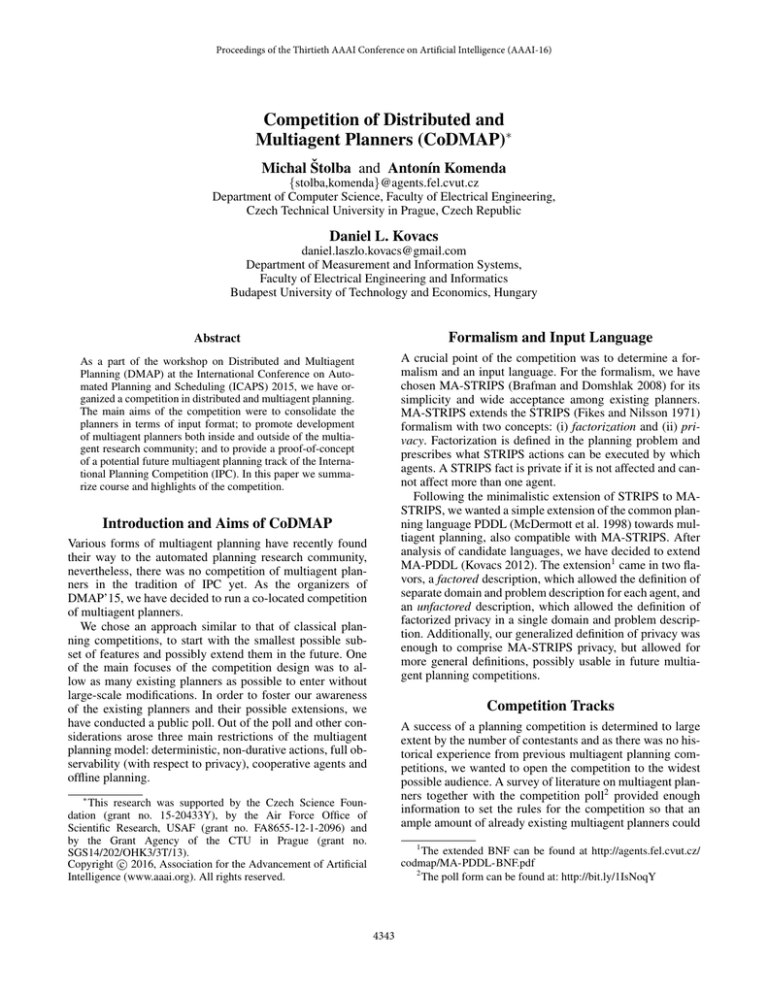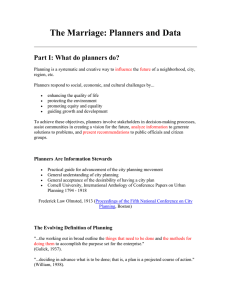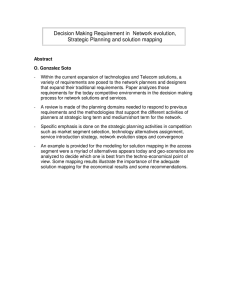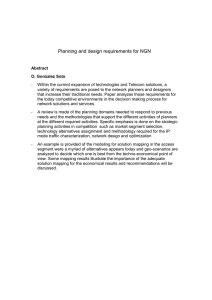
Proceedings of the Thirtieth AAAI Conference on Artificial Intelligence (AAAI-16)
Competition of Distributed and
Multiagent Planners (CoDMAP)∗
Michal Štolba and Antonı́n Komenda
{stolba,komenda}@agents.fel.cvut.cz
Department of Computer Science, Faculty of Electrical Engineering,
Czech Technical University in Prague, Czech Republic
Daniel L. Kovacs
daniel.laszlo.kovacs@gmail.com
Department of Measurement and Information Systems,
Faculty of Electrical Engineering and Informatics
Budapest University of Technology and Economics, Hungary
Abstract
Formalism and Input Language
As a part of the workshop on Distributed and Multiagent
Planning (DMAP) at the International Conference on Automated Planning and Scheduling (ICAPS) 2015, we have organized a competition in distributed and multiagent planning.
The main aims of the competition were to consolidate the
planners in terms of input format; to promote development
of multiagent planners both inside and outside of the multiagent research community; and to provide a proof-of-concept
of a potential future multiagent planning track of the International Planning Competition (IPC). In this paper we summarize course and highlights of the competition.
A crucial point of the competition was to determine a formalism and an input language. For the formalism, we have
chosen MA-STRIPS (Brafman and Domshlak 2008) for its
simplicity and wide acceptance among existing planners.
MA-STRIPS extends the STRIPS (Fikes and Nilsson 1971)
formalism with two concepts: (i) factorization and (ii) privacy. Factorization is defined in the planning problem and
prescribes what STRIPS actions can be executed by which
agents. A STRIPS fact is private if it is not affected and cannot affect more than one agent.
Following the minimalistic extension of STRIPS to MASTRIPS, we wanted a simple extension of the common planning language PDDL (McDermott et al. 1998) towards multiagent planning, also compatible with MA-STRIPS. After
analysis of candidate languages, we have decided to extend
MA-PDDL (Kovacs 2012). The extension1 came in two flavors, a factored description, which allowed the definition of
separate domain and problem description for each agent, and
an unfactored description, which allowed the definition of
factorized privacy in a single domain and problem description. Additionally, our generalized definition of privacy was
enough to comprise MA-STRIPS privacy, but allowed for
more general definitions, possibly usable in future multiagent planning competitions.
Introduction and Aims of CoDMAP
Various forms of multiagent planning have recently found
their way to the automated planning research community,
nevertheless, there was no competition of multiagent planners in the tradition of IPC yet. As the organizers of
DMAP’15, we have decided to run a co-located competition
of multiagent planners.
We chose an approach similar to that of classical planning competitions, to start with the smallest possible subset of features and possibly extend them in the future. One
of the main focuses of the competition design was to allow as many existing planners as possible to enter without
large-scale modifications. In order to foster our awareness
of the existing planners and their possible extensions, we
have conducted a public poll. Out of the poll and other considerations arose three main restrictions of the multiagent
planning model: deterministic, non-durative actions, full observability (with respect to privacy), cooperative agents and
offline planning.
Competition Tracks
A success of a planning competition is determined to large
extent by the number of contestants and as there was no historical experience from previous multiagent planning competitions, we wanted to open the competition to the widest
possible audience. A survey of literature on multiagent planners together with the competition poll2 provided enough
information to set the rules for the competition so that an
ample amount of already existing multiagent planners could
∗
This research was supported by the Czech Science Foundation (grant no. 15-20433Y), by the Air Force Office of
Scientific Research, USAF (grant no. FA8655-12-1-2096) and
by the Grant Agency of the CTU in Prague (grant no.
SGS14/202/OHK3/3T/13).
c 2016, Association for the Advancement of Artificial
Copyright Intelligence (www.aaai.org). All rights reserved.
1
The extended BNF can be found at http://agents.fel.cvut.cz/
codmap/MA-PDDL-BNF.pdf
2
The poll form can be found at: http://bit.ly/1IsNoqY
4343
Coverage
centralized track
distributed track
1.-2.
ADP (GBR)
222
1.
PSM (CZE)
180
3.
MAP-LAPKT (CAN)
216
2.
MAPlan (CZE)
174
4.
CMAP (ESP)
210
3.
MH-FMAP (ESP)
107
Table 1: Best performing planners in the metrics of solved
problems out of overall 240 benchmarks.
Evaluation and Benchmarks
Each run of a planner in the competition was restricted to
30 minutes on 4 computational cores and 8GB per machine.
The metrics used to compare the planners were coverage
(number) of solved problems, IPC Score over the plan quality, and IPC score over the planning time. In the distributed
track, the plan quality was evaluated both in terms of total
cost (sum of costs of all used actions) and makespan (the
maximum timestep of the plan if executed in parallel).
The planners were evaluated over a set of 12 benchmark domains. The domains were motivated by important and interesting real-world problems and/or by problems exposing and testing theoretical features of the planners. We used domains from literature on multiagent
planning: BLOCKSWORLD, DEPOT, DRIVERLOG, ELEVA TORS 08, LOGISTICS 00, ROVERS, SATELLITES, SOKOBAN ,
WOODWORKING , and ZENOTRAVEL, each with 20 problem instances, with varying size, number of objects, constants, agents, and thus complexity. Additionally, we have
added two novel domains inspired by well-known multiagent problems, not modeled in MA-STRIPS or MA-PDDL
previously: TAXI and WIRELESS. The first one was a model
of on-demand transport by taxis in a city, while the other
modeled a group of communicating autonomous nodes in a
wireless sensor network.
The validity and quality of plans was evaluated using the
VAL3 tool, which can handle parallel plans and performs the
mutex checks.
Figure 1: Comparison of the centralized CoDMAP track
(top two variants) and distributed CoDMAP track (bottom).
P1 , . . . , Pn represent processes of the planner. In the centralized CoDMAP track, there can be arbitrary number of
planner processes (e.g., only P1 for centralized planners).
In the distributed CoDMAP track, the processes correspond
to n agents α1 , . . . , αn running on machines M1 , ..., Mn .
Communication among the planner’s processes and (shared)
memory are denoted as comm and mem respectively. The
output plan(s) are ordered lists of k actions a1 , . . . , ak ,
where in the distributed CoDMAP, an agent’s αi action is denoted as aαi . In the case of the centralized CoDMAP track, a
planner can arbitrarily use unfactored and/or factored inputs.
compete and still the key motivations of the competition remained satisfied.
The fundamental discriminator of current multiagent
planners is whether they can work distributively on multiple
interconnected physical machines, or not. To accommodate
planners running in either modes, the competition was split
in two tracks (see Figure 1):
Selected Results
For the centralized track, we have received 12 planners in 17
configurations prepared by 8 teams. For the distributed track
6 configurations of 3 planners by 3 teams. Complete, detailed, and interactive results including detailed description
of the planners and their authors can be found on the official competition webpage4 , selected results are presented in
Table 1.
The winning planners of the centralized track were two
variants of the ADP (Agent Decomposition-based Planner) planner (Crosby, Rovatsos, and Petrick 2013) based
on the idea of automatic decomposition of classical planning problems to multiple agents, the MAP-LAPKT planner (Muise, Lipovetzky, and Ramirez 2015) based on solving of an encoded multiagent problem by a classical planner
and CMAP (Borrajo and Fernández 2015) based on subgoal
extraction and factored compilation to classical planning.
• Centralized Track, aiming for maximal compatibility with
classical IPC and existing multiagent planners; the input
of a planner was either unfactored or factored MA-PDDL;
the planners run on a single machine, with no other restrictions or requirements; communication was not restricted; privacy was not enforced.
• Distributed Track, much more strict aiming for a proper
multiagent setting; the input was limited to distributed
factored MA-PDDLs for each agent; planners run distributively on a grid of machines; planners had to communicate over TCP/IP; preservation of privacy of the local
data was required.
3
4
4344
http://www.inf.kcl.ac.uk/research/groups/planning
CoDMAP results: http://agents.cz/codmap/results
The distributed track won a variant of the PSM
planner (Tozicka, Jakubuv, and Komenda 2014) based
on intersection of finite automatons representing sets
of agents’ local plans coined Planning State Machines
(PSM). Second place occupied MAPlan (Fišer, Štolba, and
Komenda 2015), a distributed heuristic search planner. The
multi-heuristic partial-order forward-chaining planner MHFMAP (Torreño, Onaindia, and Sapena 2014) placed as
third.
References
Borrajo, D., and Fernández, S. 2015. MAPR and CMAP.
In Proceedings of the Competition of Distributed and MultiAgent Planners (CoDMAP-15), 1–3.
Brafman, R. I., and Domshlak, C. 2008. From one to many:
Planning for loosely coupled multi-agent systems. In Proceedings of the 18th International Conference on Automated
Planning and Scheduling (ICAPS’08), 28–35.
Crosby, M.; Rovatsos, M.; and Petrick, R. 2013. Automated
agent decomposition for classical planning. In Proceedings
of the 23rd International Conference on Automated Planning and Scheduling (ICAPS’13), 46–54.
Fikes, R., and Nilsson, N. 1971. STRIPS: A new approach
to the application of theorem proving to problem solving.
In Proceedings of the 2nd International Joint Conference on
Artificial Intelligence (IJCAI’71), 608–620.
Fišer, D.; Štolba, M.; and Komenda, A. 2015. MAPlan.
In Proceedings of the Competition of Distributed and MultiAgent Planners (CoDMAP-15), 8–10.
Kovacs, D. L. 2012. A multi-agent extension of PDDL3.1.
In Proceedings of the 3rd Workshop on the International
Planning Competition (IPC), 19–27.
McDermott, D.; Ghallab, M.; Howe, A.; Knoblock, C.; Ram,
A.; Veloso, M.; Weld, D.; and Wilkins, D. 1998. PDDL - The
planning domain definition language. Technical Report TR98-003, Yale Center for Computational Vision and Control.
Muise, C.; Lipovetzky, N.; and Ramirez, M. 2015. MAPLAPKT: Omnipotent Multi-Agent Planning via Compilation to Classical Planning. In Proceedings of the Competition of Distributed and Multi-Agent Planners (CoDMAP15), 14–16.
Torreño, A.; Onaindia, E.; and Sapena, O. 2014. FMAP:
Distributed cooperative multi-agent planning. Applied Intelligence 41(2):606–626.
Tozicka, J.; Jakubuv, J.; and Komenda, A. 2014. Generating
multi-agent plans by distributed intersection of Finite State
Machines. In Proceedings of the 21st European Conference
on Artificial Intelligence (ECAI’14), 1111–1112.
4345





